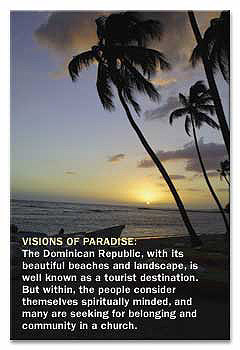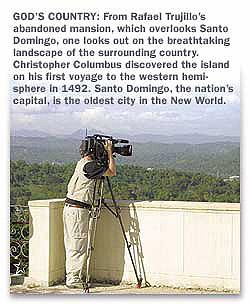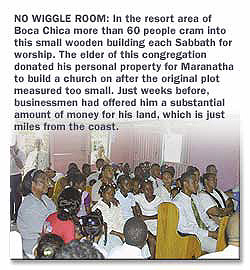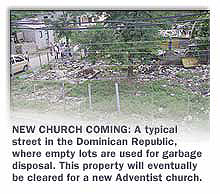BY JULIE Z. LEE
 n Barrio Nuevo, an impoverished neighborhood in the Dominican Republic, the only sign of beauty is the bright paints disguising the weathered facade of wooden shacks. Adults sit in slanting doorways, waiting for the day to end and the next to begin. Dogs roam aimlessly. A group of children play in the dirt, half clothed and without shoes. They run around in little flocks, oblivious to the garbage scattered in the streets.
n Barrio Nuevo, an impoverished neighborhood in the Dominican Republic, the only sign of beauty is the bright paints disguising the weathered facade of wooden shacks. Adults sit in slanting doorways, waiting for the day to end and the next to begin. Dogs roam aimlessly. A group of children play in the dirt, half clothed and without shoes. They run around in little flocks, oblivious to the garbage scattered in the streets.
In the midst of this small chaos a young girl stands still, looking strangely out of place. Her hair is neatly combed. She wears a nice dress, white socks, and shoes. She appears healthy and clean.
Someone points her out.
�Oh, her,� replies a man who is familiar with the community. �Her mother is a Seventh-day Adventist.�
Blazing Fires
I am in the Dominican Republic on a writing assignment to observe the remarkable growth of the Seventh-day Adventist Church. In the past 10 years Adventism has witnessed a tremendous increase in membership in this country�currently numbering 150,000. This number saw another increase earlier this year when 20,000 people were baptized as a result of a special evangelistic drive.
The history of the growth spurt in the country began in 1992. Maranatha Volunteers International (MVI) received a request from local Adventist church leaders asking Maranatha to assist them in their need for churches. While many people were interested in the gospel, most of the new congregations were without church homes and were forced to meet in sheds, parks, and other unsatisfactory venues.
 In their first large-scale project Maranatha embarked on a campaign to build 25 churches in the country. The project served as a catalyst for growth. Since then, most of the churches built have doubled in membership, creating multiple new groups from a single congregation. One church, La Caleta, has spawned 12 new groups while maintaining a membership of 250! People are showing a powerful attraction to the Adventist message. Evangelistic meetings in the country are standing room only, as hundreds gather in and around some small building to hear the Adventist message. People gather for prayer meetings at the first hint of dawn and again in the evenings after work. In January 2002 an evangelistic series conducted by South American evangelist Alejandro Bullon filled the 15,000-seat Sport Palace stadium in Santo Domingo, the nation�s capital, with thousands more watching or listening on television and radio. Enthusiasm for the gospel is alive and far from waning.
In their first large-scale project Maranatha embarked on a campaign to build 25 churches in the country. The project served as a catalyst for growth. Since then, most of the churches built have doubled in membership, creating multiple new groups from a single congregation. One church, La Caleta, has spawned 12 new groups while maintaining a membership of 250! People are showing a powerful attraction to the Adventist message. Evangelistic meetings in the country are standing room only, as hundreds gather in and around some small building to hear the Adventist message. People gather for prayer meetings at the first hint of dawn and again in the evenings after work. In January 2002 an evangelistic series conducted by South American evangelist Alejandro Bullon filled the 15,000-seat Sport Palace stadium in Santo Domingo, the nation�s capital, with thousands more watching or listening on television and radio. Enthusiasm for the gospel is alive and far from waning.
Such growth is incredible news for the Adventist Church. But the question remaining to be asked is: Why? What�s behind the numbers, and what�s attracting the people?
During my five-day visit, through a series of interviews with Adventists, their neighbors, and random strangers on the street, I set out to uncover what draws ordinary people to the Adventist Church and discover the cultural implications of such growth.
Finding the Context
Santo Domingo�s maze of highways and fashion boutiques can easily fool the tourist into believing that despite reports of intense poverty, the country is quite modern, with decent living standards. But press past the ocean perimeter of hotels, and reality eclipses first impressions.
In the hills outlining Santo Domingo, scrap metal homes are built directly into the slopes. It invokes a flashback to ancient Indian pueblos carved straight into the canyons�only these houses are piled on the hillside without a hint of order. It looks as if a minor earthquake could shake hundreds of families into the crevice below. Farther away from �tourist central� there are neighborhoods constructed from scrap materials found on the spot where the locals reside. In the poorest areas naked children play in roads where broken bottles, diapers, and all sorts of refuse line the path.
 Although the past 10 years have brought about notable progress in the country�s economic growth, the Dominican Republic still wrestles with poverty. According to a U.S. government publication, more than 25 percent of the population lives below the poverty line. Many reside in rural areas far past the city, where the arms of social programs don�t quite stretch.
Although the past 10 years have brought about notable progress in the country�s economic growth, the Dominican Republic still wrestles with poverty. According to a U.S. government publication, more than 25 percent of the population lives below the poverty line. Many reside in rural areas far past the city, where the arms of social programs don�t quite stretch.
Yet a growing number of Dominicans have found an alternative to rely on for help: the church.
�Religion means we don�t have to depend on human government,� answers a woman when I ask why she thinks Dominicans are committed to church.
It is a telling answer. The Dominican Republic has a history of corrupt politics and government. Reform is on its way up, but because of the failure of past efforts to fight poverty, the people�s confidence in the government has declined. Government-implemented social programs are met with lackluster response and with distrust, making improvement all the more difficult. People tend to believe that structural-adjustment policies are motivated more by politics than by genuine concern. As one young Dominican puts it, �politics is the worst thing in this country. Politicians promise but don�t deliver. Once they are elected, they forget about the people.�
Religion, on the other hand, offers an alternative to the fallible character of people. The nature of God and a relationship with Him is based on trust and selfless leadership that can be counted on. Ultimately, religion offers hope, and spirituality is sustenance.
�The principal thing is that people here are very religious,� says Adventist pastor Rafael Solis. �They are looking for God. Our message brings hope to people, and they are searching for hope.�
Yet hope in the Dominican Republic is a multidimensional offering, particularly when it comes to the Adventist Church. Here Adventists work hard to build community, bringing social programs that are not rooted in political initiatives.
Instead, the Adventist Church offers effective principles for everyday living taken right out of the Bible�a fact that�s not lost on the Dominicans. Many comment on the straightforward honesty of the Adventist faith, which doesn�t try to twist or undermine the Bible. Honesty is a great factor, and the simple truths of Adventist teachings have convinced many people to listen.
 �Adventists preach what�s from the Bible, and we live what we believe,� says Pastor Solis. �Personal testimonies reveal the internalization of the beliefs.�
�Adventists preach what�s from the Bible, and we live what we believe,� says Pastor Solis. �Personal testimonies reveal the internalization of the beliefs.�
The results of such internalizations are dramatic. In towns in which an Adventist church is built, transformation is inevitable. People are discovering a plan for living that actually works.
Cambita Garabito is a small town where the Adventist church is well known. Before a church was built in the center of town several years ago, the town was torn by riots, stabbings, gambling, and drugs. Today the streets of Cambita Garabito are peaceful.
�Many people are asking, �What has happened? This neighborhood is now quiet,�� says Wascar Ruiz, a lay preacher and member of the local church. �But I�m not surprised. It�s because of the gospel. People are attracted to the Adventist lifestyle. Ever since the church was built the membership has tripled.�
Even those who have not committed to Adventism recognize the benefits it�s had on their community. Milagro Delgado, a resident of the Cambita Garabito community, is not an Adventist, but she is familiar with the faith. �The Adventists keep the commandments like God commands,� she says, �better than other churches. It is a good religion. It�s changed the town a lot. People are staying away from the diversions of gambling and other vices that waste their time and money.�
�The Adventists are different, special,� says a teenager who goes by the name of Wilkin. �They are people who follow the commandments; that�s how they can be recognized. Most of them have programs of assistance�medical, humanitarian, all of that. Cambita Garabito used to be one of the most dangerous places. Nobody who lived here was trustworthy. When the church was built, it revolutionized the community. It�s been a big change for those who live here.�
The Adventist Church�s emphasis on health is also an important factor. Medical care is difficult for the poor to receive, and health education is weak. Adventists educate the community on how to care for themselves, teaching hygiene and proper eating habits and distributing medicine.
�There used to be a lot of sick people coming to church, but there aren�t as many anymore,� says Ruiz. �Now they are well. The church has taught them how to eat and live healthfully.�
Adventists also provide an alternative to the country�s ineffectual public education system. National assessment tests show that privately schooled children score higher than those enrolled in public schools, and Adventist schools are no exception. Accordingly, Adventist education is regarded highly. The people I interviewed were positive about Adventist schools and hope to enroll their children if and when a facility is built in their town.
 But an unexpected benefit has come from the establishment of Adventist schools. They�ve become evangelistic tools. According to the Dominican Union Mission president, Cesario Acevedo, there are 18,000 students in Adventist schools, 70 percent of whom come from non-Adventist homes.
But an unexpected benefit has come from the establishment of Adventist schools. They�ve become evangelistic tools. According to the Dominican Union Mission president, Cesario Acevedo, there are 18,000 students in Adventist schools, 70 percent of whom come from non-Adventist homes.
�Church education is highly significant because it�s one of the evangelistic centers for children,� says Gregori Castro, a pastor in La Caleta, a town with a large church school. �When we educate the children, we�re evangelizing the parents, since a significant percentage of the children�s parents are not Adventist. The children are transformed, and then they in turn influence their parents.�
A Complete Church
Beyond establishing effective social programs, the Adventist Church in the Dominican Republic makes sure the gospel is shared widely and effectively. Armando Miranda, a general vice president at the Adventist Church�s world headquarters in Silver Spring, Maryland, says that the Inter-American Division has been working hard to promote collaboration between laypeople and pastors. Every year church leaders take time to train laypeople in mission work. The Adventist church also has six radio stations in the Dominican Republic, covering most of the country.
By culture Dominicans have friendly, outgoing personalities, and Adventists are eager to talk about their church. Striking up a conversation about God and faith comes without inhibitions. Church members frequently visit neighbors, inviting them to worship and Bible studies. Relation-ships are essential, and anyone in need of help receives it. When asked, most say �friendliness, hospitality, and a tendency to help anyone in need� are the defining characteristics of a Dominican.
Such a temperament lies at the heart of Christianity.
In his book Believing, Behaving, Belonging Richard Rice discusses the importance of community as a profound element in religion. He writes, �From its very beginning, the Christian community has been an expanding community. The very nature of fellowship in Christ leads its participants to reach out and draw others in.� What results are tightly knit relationships and a shared identity.
In the town of Boca Chica I talk with a Dominican woman who is standing in front of her store. She sells a variety of practical items for the home. Down the street, the Adventist church is just wrapping up Sabbath worship. She says she used to belong to an Adventist church. She says church is an important part of her life. It means having a community to welcome you wherever you go�much like a built-in family. But when she moved to a new neighborhood some time ago, there was no Adventist church nearby. Needing Christian fellowship, she finally joined another denomination.
In wealthier and more developed nations life can center on faith; few rely on church for survival. But in a country where basic needs are neglected, church seems to have become a fundamental in itself.
Julio Figuereo, secretary-treasurer of the Southeast Dominican Mission, believes that in the Dominican Republic, church is a lifeline.
 He says, �In a community without light the church is a generator.�
He says, �In a community without light the church is a generator.�
I recall my first day out in the field in Canefisto, a small town about an hour from Santo Domingo. I had met Altagracia Mejilla and Victoria
Arias, two devout Adventists who have been opening their living rooms for Sabbath worship for years. They organize various activities for the members and the community and give sermons on the days their pastor is preaching in another town. Soon a church will be built in Canefisto, and the women are excited about the possibilities.
�The church will be a witness to the world that we worship the living God,� said Mejilla. �People can take refuge here in the church and be spiritually refreshed.�
As the women talked, a toddler dressed in an outfit of leftover t-shirts stood barefoot on the sidewalk. A group of boys began a game of baseball. Mangy animals surveyed the street, and old men sat on their dilapidated porches, waiting for a new day. In the background there was an empty lot littered with trash. This is where the new church will be built. This is a place where the Adventist faith can bloom to its fullest potential.
Physical need is not an attractive basis to build a faith on�particularly to those who cannot comprehend the real concept of need�but this is an example of church coming alive in its most complete form. God and His teachings are life. It is a truth that is recognized and embraced by these people.
�Many Christians will come to the feet of Jesus when the church is built,� said Arias. �Just like Noah and the ark when the animals came two by two, the people will come a hundred by a hundred.�
In the Dominican Republic the light is growing brighter.
_________________________
Julie Z. Lee is communication coordinator for Maranatha Volunteers International and a freelance writer. She lives in Napa, California.


